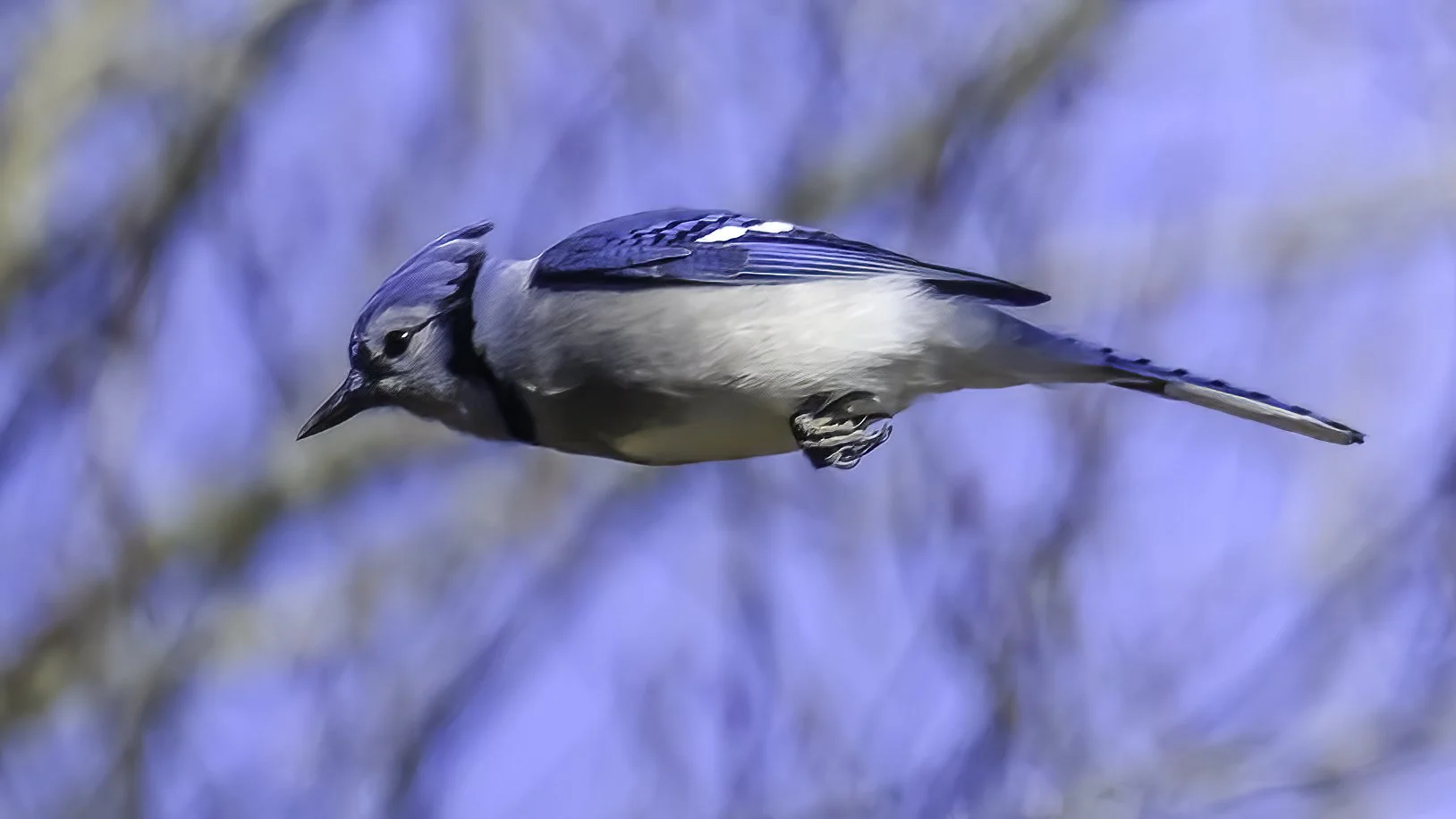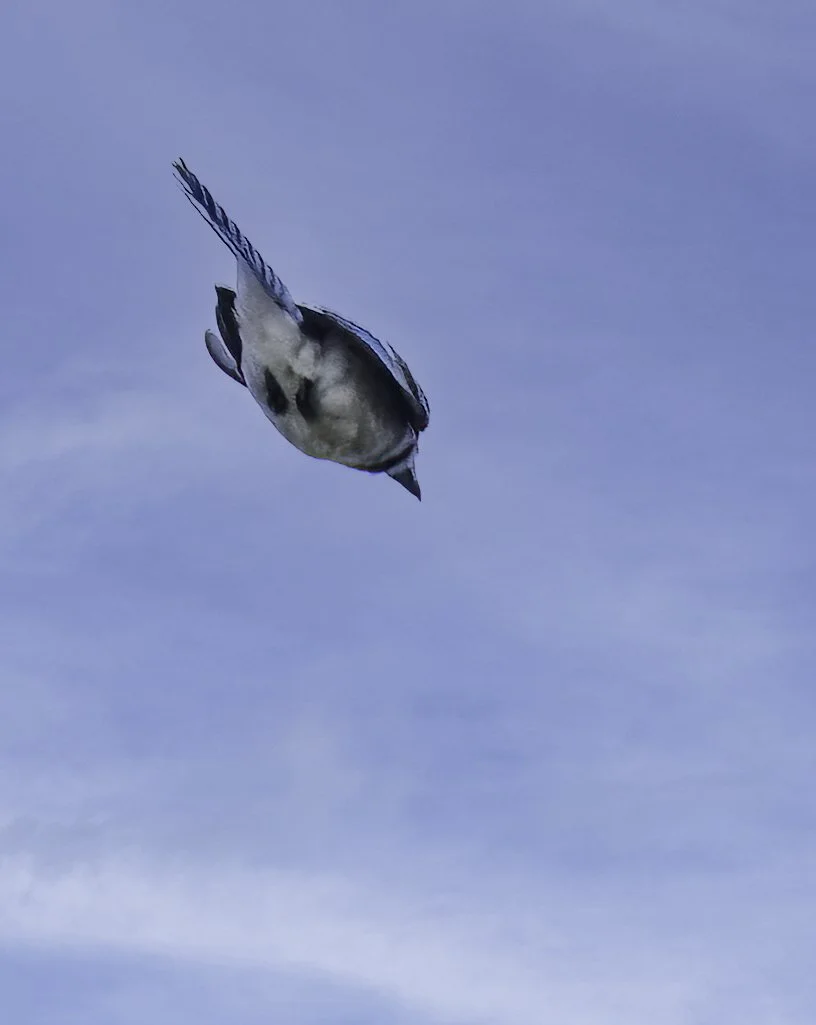Blue Jays on the move…
Blue Jay takes flight over the Shawangunk Ridge
The more appropriate title of today’s post would probably be “Some Blue Jays on the move….” For whatever reason, Blue Jays are what are known as “partial migrants”. Some jays migrate and others don’t. Not only that, but some Blue Jays migrate during certain years and then stay put the very next year! And when they do migrate, some fly together with their “feather-mates” in flocks of half a dozen or so while others team up with thousands of other jays as seen over the Great Lakes in recent years.
Blue Jay over the Shawangunk Ridge
We have yet to see large groups of jays migrating over Bear Mountain this year, but we have had groups of a half dozen or so flying in and occasionally landing in the nearby trees and then heading south. Apparently, the birds will begin their migratory flight about an hour after sunrise, take a break around noon, and then resume their southerly flight later in the afternoon. What migration does occur happens between mid September and into October.
If you have feeders set up on your property or simply just spend time in the great outdoors, you too have probably noticed an uptick in the presence of these beautiful blue birds. At our site in Bear Mountain Hawkwatch, on more than one occasion someone will call out a possible “Sharpie” (Sharp-shinned hawk) flying by only to quickly realize it is one of a group of jays flying though. Jays give the impression of a “love” of flying and will often be seen doing a “stoop” at tree-top level down the mountain side as seen in this shot taken recently.
Blue Jay in a “stoop” at Bear Mt Hawkwatch 9/28/25 Nikon Z8 set to DX mode ISO 125, 400mm with 1.5 crop factor for apparent 600mm, F/8, 1/1000 sec
It is not really known for sure why some Blue Jays migrate while others do not. Some blue jays possibly migrate primarily in response to food availability and harsh winter conditions. While many blue jays remain in their breeding range year-round, those living in northern areas may travel southward during colder months to access more reliable food sources such as acorns, nuts, and insects. This partial migration varies among individuals and populations, influenced by environmental factors and the severity of the winter. And yet, Blue Jays are often found in conditions that defy logic…bitter cold and heavy snows. So why do they remain behind? Guess you’ll just have to ask a Blue Jay next time one comes flying by. Til then, just keep your eyes to the skies in the hopes of catching a view of these handsome birds “on the move”.
Tech Tip - Certain cameras are what are known as APS-C cameras. These cameras are generally a bit smaller in size and have a smaller sensor within the body of the camera. Contrary to some reports, these cameras do not “increase” the focal length of your lens. Rather, they increase the apparent focal length by capturing a smaller section of the image the lens projects back to the sensor…in other words, cropping the image in-body. Basically, this results in the same results you would get if you shot the image through a full-frame camera and then cropped it using post-production software by a factor of 1.5. So, you do magnify the image you get from your lens, but you are also using less of the full-frame sensor and thus get less resolution. That being said, on a high-end full frame camera with a 45.7 MP sensor like the Nikon Z8, if you set it to capture the image with a 400mm lens and the camera set to the APS-C format (known as DX in Nikon verbiage), the lens would act like a 600mm lens but you would only use a portion of the sensor that amounts to just under 20 MP. Is that horrible? No, not at all. Consider the fact that Nikon’s D500, one of its most popular mirrored cameras, has a 20.9 MP sensor and is fully capable of producing images which can be greatly enlarged at minimal loss of resolution. So, do you lose anything by setting your camera to the DX mode to get more apparent magnification? Short answer , yes. Reality, not a game changer. The main reason, I usually do not use DX mode on my Z8 or Z9 is that by using the full frame, I have more of an original image to work with when cropping. I decide what to crop rather than having the camera do it for me. The image of the Jay in the stoop position was taken with the DX setting and did not cause me to lose any resolution that you could see on an image for publication on a web site like this. The choice is yours.



